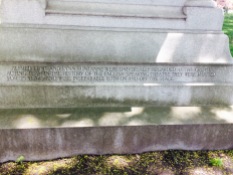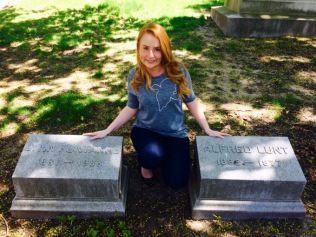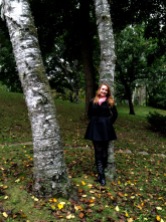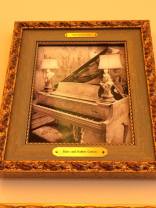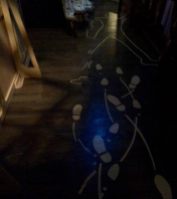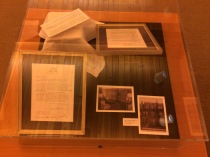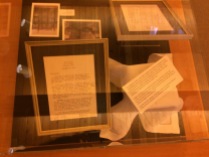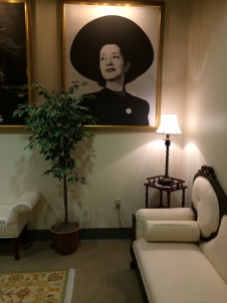
“Acting is the art of speaking in a loud, clear voice and the avoidance of bumping into the furniture.” –Alfred Lunt
There are many notable names in theatrical history but the husband and wife pairing of Alfred Lunt and Lynn Fontanne is particularly special. An inseparable duo, the team entertained a wide range of audiences throughout countless shows. Their romance continues to intrigue visitors to this day thanks to a key remnant from their love story: Ten Chimneys.
Alfred Davis Lunt, Jr. was born in Milwaukee, Wisconsin in 1892 to Alfred D. Lunt and Harriet Washburn Briggs. After his father, who was in the lumber business, died in 1893, Alfred’s mother remarried a Finnish-born physician, Dr. Karl Sederholm, and had another son and two daughters. The Sederholms eventually moved to Genesee Depot, in Waukesha County, Wisconsin. Lunt later attended Carroll College in nearby Waukesha, Wisconsin.
Lunt became a star in 1919 as the buffoonish lead in Booth Tarkington’s play, Clarence, but soon distinguished himself in a variety of roles. He was described by director and critic Harold Clurman as “universally acclaimed the finest American actor in the generation which followed John Barrymore.”

Lynn Fontanne was born Lillie Louise Fontanne in Woodford, London. She drew acclaim in 1921 playing the title role in the George S. Kaufman-Marc Connelly farce, Dulcy. She soon became celebrated for her skill as an actress in high comedy, excelling in witty roles written for her by Noël Coward, S.N. Behrman, and Robert Sherwood. However, she enjoyed one of the greatest critical successes of her career as Nina Leeds, the desperate heroine of Eugene O’Neill’s controversial nine-act drama Strange Interlude.
Alfred married Lynn Fontanne on May 26, 1922, in New York City. From the late 1920s on, Fontanne acted exclusively in vehicles also starring her husband. Lauded as a beloved theatrical couple in a happy marriage, they delighted in playing a broad range of roles. Among their many portrayals, they enjoyed playing adulterers, as in Robert Sherwood’s Reunion in Vienna, or as part of a menage a trois in Noël Coward’s Design for Living. In fact, Coward was a dear friend of theirs and wrote Design for Living specifically for the three of them.

Fontanne and Lunt worked together in 27 productions. Of her acting style with Lunt, British broadcasting personality Arthur Marshall – having seen her in Caprice St James’s Theatre (1929) – observed: “In the plays of the period, actors waited to speak until somebody else had finished; the Lunts turned all that upside down. They threw away lines, they trod on each others words, they gabbled, they spoke at the same time. They spoke, in fact, as people do in ordinary life.”
Though the Lunts appeared together in more than twenty plays, they also made two films together: The Guardsman (1931), in which they starred, and Stage Door Canteen (1943) in which they had cameos as themselves.

Lunt received two Tony Awards, an Academy Award nomination for Best Actor for 1931’s The Guardsman and an Emmy Award for the Hallmark Hall of Fame’s production of The Magnificent Yankee. Fontanne was nominated for a Tony Award for one of her last stage roles, in The Visit (1959).
In 1958 they retired from the stage. They starred in several radio dramas for the Theatre Guild in the 1940s, and starred in a few television productions in the 1950s and 1960s.
Summers during their days of performing on stage and their subsequent retirement years were spent at their home “Ten Chimneys” at Genesee Depot in Lunt’s home state of Wisconsin. A host of stage and screen luminaries made pilgrimages to Genesee Depot as guests of the Lunts, including Noël Coward, Helen Hayes, Laurence Olivier, and Vivien Leigh. Carol Channing said, “If you get to go to Ten Chimneys, you must have done something right.”
Upon retirement, the Lunts returned to Ten Chimneys and spent the rest of their lives at their beloved home in Genesee Depot.

The Lunts are buried in the Lunt family plot at Forest Home Cemetery in Milwaukee, Wisconsin. They are buried in Section 33, lot 42. Their graves are not visible from the street but they are roughly in the middle of the section.
While Lunt’s childhood home no longer stands, the Pabst Theatre in his hometown of Milwaukee has small exhibits featuring various theatrical talents. The displays celebrate the likes of Helen Hayes, cabaret singer Hildegarde, as well as the Lunt-Fontanne duo. The Pabst Theatre is located at 144 E Wells St. in Milwaukee.
Ten Chimneys, Lunt and Fontanne’s estate in Genesee Depot, located in Waukesha County, Wisconsin, is now a house museum and resource center for theater. The Lunt-Fontanne Theatre in New York was named in honor of Lunt and his wife.
The estate takes its name from the number of chimneys on the grounds.Buildings include a large main house, a cottage, a Swedish log cabin studio, an L-shaped pool, pool house, creamery, greenhouse, barns, stables, and other outbuildings.
Arts advocate Joseph W. Garton, a restaurateur in Madison, Wisconsin, purchased Ten Chimneys. In 1996, Ten Chimneys Foundation was established to preserve and share the estate. The foundation then purchased the property from Garton in 1998.
As a historic property, the estate was exceptionally well preserved, since the Lunts’ original furniture, decorations, and personal items were barely disturbed between Lynn Fontanne’s death in 1983 and the beginning of preservation efforts by Ten Chimneys Foundation in 1998.
Ten Chimneys Foundation opened the estate to the public for the first time on May 26, 2003, which would have been the Lunts’ 81st wedding anniversary. The estate remains open for public tours from May through November. Ten Chimneys Foundation also continues to fulfill the estate’s original role as a home for the arts by providing programming and resources for theater professionals. Ten Chimneys is located at S43 W31575 Depot Rd.

Thanks to the efforts of the Ten Chimneys Foundation, Ten Chimneys continues to entrance visitors from all over the world. Visitors may schedule tours of the grounds and buildings. They are also encouraged to visit during an “All Access Day,” in which guests wear period attire and take part in festivities on the grounds of Ten Chimneys, such as taking a dip in the L-shaped pool!
Upon parking at Ten Chimneys, I checked in to take my guided tour. The tour began with our group watching the following video to gain background knowledge about Lunt and Fontanne.
We then boarded the bus and began chatting with our fantastic tour guide. Visitors were guided through all the buildings on the grounds as well as points of interest outdoors. The Ten Chimneys Foundation has a strict “no photo” policy when inside of the historical buildings. However, visitors are allowed to take as many photos as they like outside of the buildings and within the museum.
The grounds are very well kept, boasting a history of their own. Author Alexander Woollcott gifted the birch trees clustered on the hill behind the red cottage to the Lunts, saying that it “needed more color.” Here I am standing in front of one of them.
Alfred maintained a garden at Ten Chimneys. There are stories of Lynn naming and feeding the different chipmunks that visited the property. Since the chipmunks ran through the gardens, there are also stories of Alfred going hunting on the grounds, unbeknownst to his wife.
There are several buildings on the property, including their home, a cottage, a pool house, and cabin. All of the locations are furnished beautifully and in some cases newly restored. To walk through Ten Chimneys is a personal and moving experience, as one is able to walk in the footsteps of theatrical royalty. Visitors can admire the opulence and glamour in every corner and delight in memorable Ten Chimneys tales. One can learn about Noel Coward’s friendship with Lunt and Fontanne, visit “Larry’s Room,” aptly named for Sir Laurence Olivier, see a gorgeous piano played by Van Johnson, among others, and so much more. One can easily imagine Ten Chimneys filled with the mirth of so many great entertainers.
Once the tour is over, visitors are encouraged to look at the many interactive exhibits at the museum. The halls are lined with an impressive amount of photos that boast the authenticity of Ten Chimneys. As visitors examine the photos, they can easily connect them to the rooms they just toured.
Many of the exhibits at the museum allow visitors to experiment with Lunt and Fontanne’s stage career. Visitors can try out costumes and even act out a few scenes among some backdrops. Ushers Laurence Olivier and Noel Coward welcome you into the beautifully designed exhibits.
The museum also features some terrific costume reproductions for visitors to try out!
While Ten Chimneys celebrates the legacy of Lunt and Fontanne, it also continues to host performers and offer classes for aspiring actors. History and art continue to flourish at Ten Chimneys–an endeavor I am sure that Lunt and Fontanne would applaud.
For more information, please visit the Ten Chimneys Foundation website.





